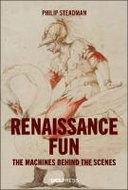Explore

Renaissance Fun is about the technology of Renaissance entertainments in stage machinery and theatrical special effects; in gardens and fountains; and in the automata and self-playing musical instruments that were installed in garden grottoes. How did the machines behind these shows work? How exactly were chariots filled with singers let down onto the stage? How were flaming dragons made to fly across the sky? How were seas created on stage? How did mechanical birds imitate real birdsong? What was ‘artificial music’, three centuries before Edison and the phonograph? How could pipe organs be driven and made to play themselves by waterpower alone? And who were the architects, engineers, and craftsmen who created these wonders? All these questions are answered. At the end of the book we visit the lost ‘garden of marvels’ at Pratolino with its many grottoes, automata and water jokes; and we attend the performance of Mercury and Mars in Parma in 1628, with its spectacular stage effects and its music by Claudio Monteverdi – one of the places where opera was born. Renaissance Fun is offered as an entertainment in itself. But behind the show is a more serious scholarly argument, centred on the enormous influence of two ancient writers on these subjects, Vitruvius and Hero. Vitruvius’s Ten Books on Architecture were widely studied by Renaissance theatre designers. Hero of Alexandria wrote the Pneumatics, a collection of designs for surprising and entertaining devices that were the models for sixteenth and seventeenth century automata. A second book by Hero On Automata-Making – much less well known, then and now – describes two miniature theatres that presented plays without human intervention. One of these, it is argued, provided the model for the type of proscenium theatre introduced from the mid-sixteenth century, the generic design which is still built today. As the influence of Vitruvius waned, the influence of Hero grew.
This book is included in DOAB.
Why read this book? Have your say.
You must be logged in to comment.
Rights Information
Are you the author or publisher of this work? If so, you can claim it as yours by registering as an Unglue.it rights holder.Downloads
This work has been downloaded 73 times via unglue.it ebook links.
- 73 - pdf (CC BY-NC-ND) at OAPEN Library.
Keywords
- Art
- History
- History of art & design styles: c 1400 to c 1600
- History Of Art / Art & Design Styles
- Performance
- Renaissance
- Renaissance Art
- The arts
- Théâtre
- Theatre Studies
- thema EDItEUR::6 Style qualifiers::6R Styles (R)::6RC Renaissance style
- thema EDItEUR::A The Arts::AG The Arts: treatments and subjects::AGA History of art
- thema EDItEUR::A The Arts::AT Performing arts::ATD Theatre studies
Links
DOI: 10.14324/111.9781787359154Editions

